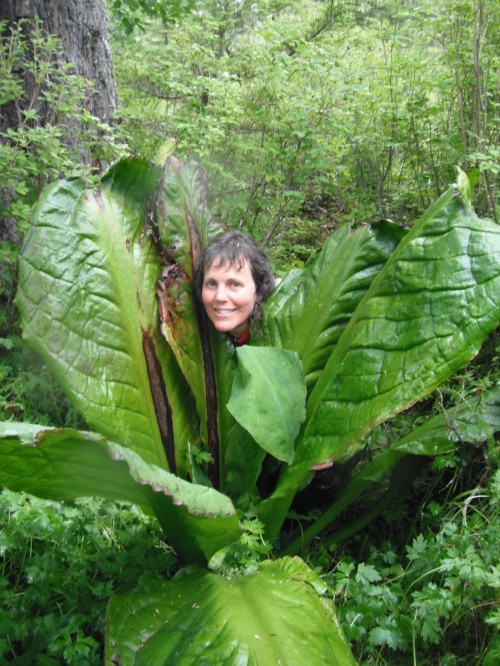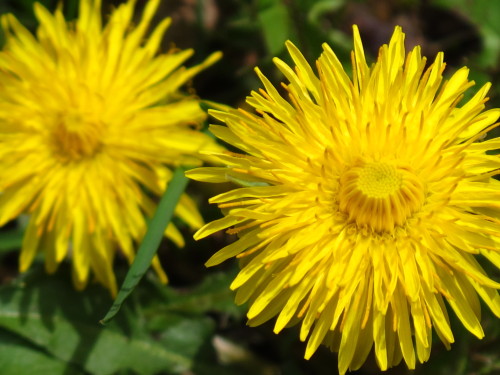Wild Eats! Forage on Lopez Island with Jennifer Hahn

Wild Eats From Land to Sea in the San Juan Islands
Saturday, June 14, 8:00am to Sunday, June 15, 5:00pm
Lopez Island, WA
Imagine fulfilling your desires for eating local food, learning cool new things, becoming more self-sufficient and connecting with nature. Now imagine doing all of them simultaneously.
Really?! Yes, I know, how could so much good stuff happen all at once? But it’s not a too-good-to-be-true proposition.
Jennifer Hahn, an a expert on wild food foraging and an adjunct professor in Western Washington University’s Fairhaven College of Interdisciplinary Studies, is leading an adult field class on Lopez Island through the North Cascades Institute in mid-June. [Jaw-drop here]. As she tempts us in her book, Pacific Feast: A Cook’s Guide to West Coast Foraging and Cuisine (Skipstone Press, 2010): “Imagine for a moment one long feast table spanning from the islands of Yakutat Bay in southwest Alaska to Point Conception, California, and beyond, rising from the Pacific Ocean to the Cascades crest.” [Begin salivating here.] Part cookbook, part bioregional natural history escapade, Pacific Feast reveals that nearly 180 different species were once central to the food traditions of the West Coast indigenous people, and offers 65 recipes celebrating them. [Dig in, here.]
“Ever try nettle pesto, rose petal truffles, ginger-sesame seaweed salad, kelp-wrapped BBQ salmon or Douglas-fir sorbet?” –www.ncascades.org
Hahn does not write up a standard itinerary for the weekend program in advance, saying instead that she likes to “keep it wide open,” which makes sense considering nature is always changing. “I wait and see what is blooming/growing/sprouting/flagging my wild attention, then I plan the two days around that,” she wrote to Chattermarks in a recent email. The trip is timed to take advantage of both the abundance of spring and extreme low tide so nutrient-packed sea veggies are easily harvestable.
The schedule includes a daily afternoon feast, preparation and cooking, practice in plant identification and learning foraging ethics. Was the daily afternoon feast mentioned?
A sampling of foraged foods. What an interesting shift to consider ingredients as species rather than just products from the grocery store that you have to eat before they spoil in your fridge! Photo from Hahn’s website.
Basecamp for the program is Group Camp Three in Spencer Spit State Park. Lopez Farm Cottages is an available option if the cute indoors are personally preferable to tentin’ it.
The weekend is not only about tasty treats but also about sharpening a sense of connection and reciprocity with the natural world. Hahn is attentive to her “Sustainable Foraging Guidelines” in her 6-fold laminated “Pacific Coast Foraging Guide” (Mountaineers Books, 2010), and will teach participants what to be of mindful of while harvesting. Her “Stewardship” guidelines are not only on-the-mark but are clever, too:
Sustain native wild populations.
Tread lightly.
Educate yourself.
Waste nothing.
Assume the attitude of a caretaker.
Regulations and laws – follow them.
Don’t harvest what you can’t ID.
Share with wildlife.
Harvest from healthy populations and sites.
Indigenous people’s traditional harvest sites deserve respect.
Pause and offer gratitude before you pick.
Pacific Feast has plenty of impressive foodie recipes, distinct from a dish from an Alice Waters cookbook by the foraged focal point and Pacific Northwest bent (e.g. “Oyster Mushroom Pizza with White Truffe Aioli” by Peter Jones of Arcata, CA, or “Huckleberry and Port Wine Sorbet” by Bellingham’s Lynn Berman). But in this blog post I wanted to provide something easily accessible to everyone, a product with few ingredients that was quick to make, delicious and empowering.
Thus, get ready for a pre-trip teaser of “Dandelion Syrup.” As a non-native weed, dandelions (Taraxacum officinale) have a pretty negative reputation. But once one knows how to harvest and prepare them – the roots, leaves and flowers are all edible and good for you – stepping outside is akin to going to the Co-op. Wild dandelion greens are wildly more nutritious than the domesticated greens from the store, and they’re free (perhaps you could even get paid for weeding them from a neighbors garden?). With their toothy leaves and sunshiny flowers, dandelions are one of the most recognizable species. Unlike various wild plants that have look-alike, fatally toxic relatives (think wild carrots and poison hemlock), dandelions have no poisonous dopple-gangers. The following recipe uses their bright yellow petals for a simple addition to your kitchen.
Dandelion Syrup
By Jennifer Hahn
(As seen in Pacific Feast: A Cook’s Guide to West Coast Foraging and Cuisine (Skipstone Press, 2010)
The taste of dandelion syrup reminds me of tangy lemongrass with honey. It’s a delicious treat drizzled on waffles, pancakes, berries, or baklava. Stir it into tea for a nutritious sweetener, or mix it with warm water until dissolved and add ice for a refreshing dande-lemonade. I’ve made this syrup with sugar and agave nectar. The latter gives the syrup a haylike overtone, reminiscent of a summer day lying in a field chewing on a spring of grass. Sugar gives the syrup a yanglike zing.
Yield: 1 ½ cups syrup
4 cups dandelion petals
4 cups water
½ organic lemon
2 cups sugar or agave nectar
In a medium stockpot bring the dandelion petals and water to a boil. Turn of the heat immediately. Let steep covered 8 hours or overnight.
Pour dandelion tea through a strainer to remove the petals. Press the pulp into the sieve with the back of a spoon or your hand – or ball up the mash like you are making a snowball and squeeze the last liquid out.
Measure the remaining dandelion tea. Add water if it is less than 4 cups and pour into a clean stockpot.
Slice lemon into rounds and remove seeds. Add lemon rounds and 2 cups of sweetener to stockpot. Stir well to dissolve sweetener. Simmer uncovered over low heat for 1 hour. As evaporation lowers the liquid level, lower the heat for a constant simmer. (A sugar-sweetened syrup will thicken faster than syrup sweetened with agave). After 1 hour, check the consistency by spooning a bit onto a plate and cooling it in the fridge for a few minutes. The syrup thickens as it cools, and it is ready if it beads up. If you like thinner syrup, reduce the cooking time; if you like a thick, honey-like consistency, cook 15 to 30 minutes more.
While it is still hot, strain the syrup through a fine sieve into jars. Set aside the “candied lemon wheels” on a plate to dry. Add them to hot tea or ice cream. Dandelion syrup will deep for six months or more in the fridge.
Get inspired with this 2:25 minute sample of what it’s like to forage with Jennifer Hahn.
Find more information on how to sign up for Wild Eats here.
 Eat me. Photo by author.
Eat me. Photo by author.
Leading photo: Foragers become one with their chosen plants. Jennifer Hahn and broad-leaved foliage. Photo from Jennifer Hahn’s website.
Katherine Renz is a graduate student in North Cascades Institute and Western Washington University’s M.Ed. program. Like a true nature’s child, she was born, born to be wild.



Taking this class was one of my highlights during my 5 years working at NCI. Jennifer is an amazing instructor and an inspiration. If this class isn’t full I am sure it will be soon.